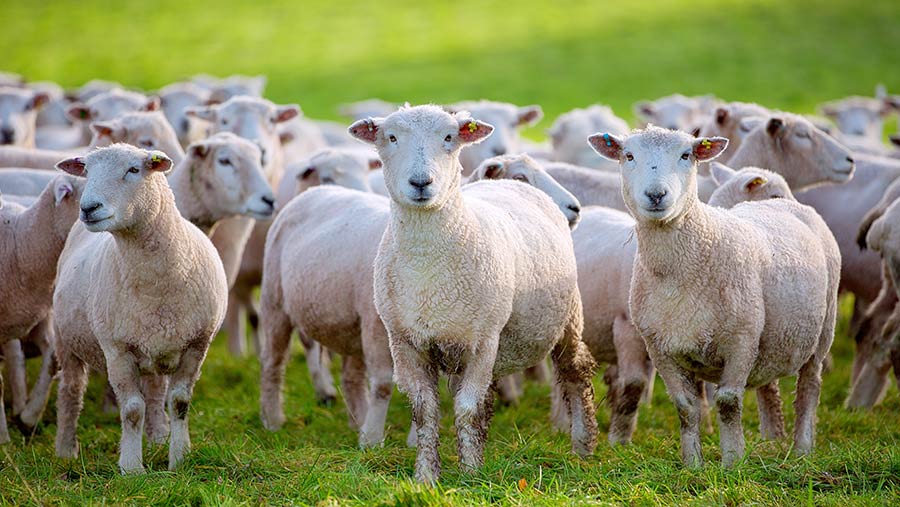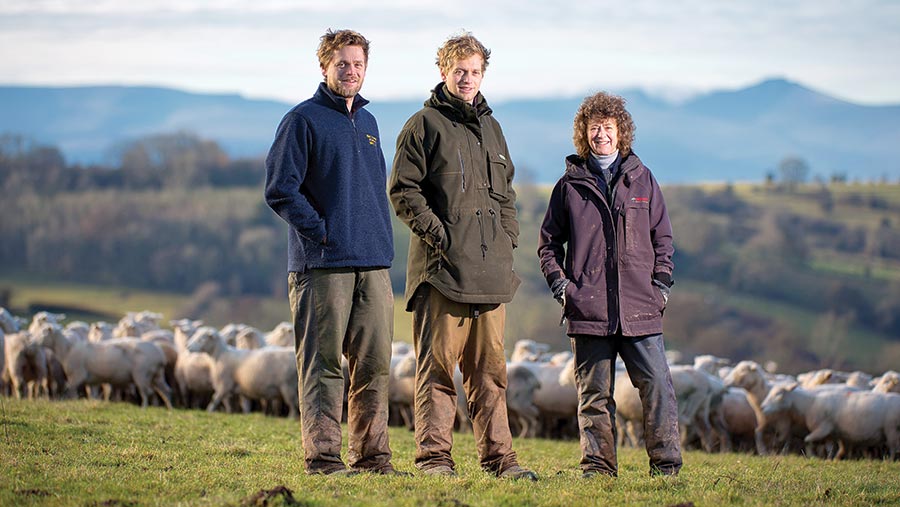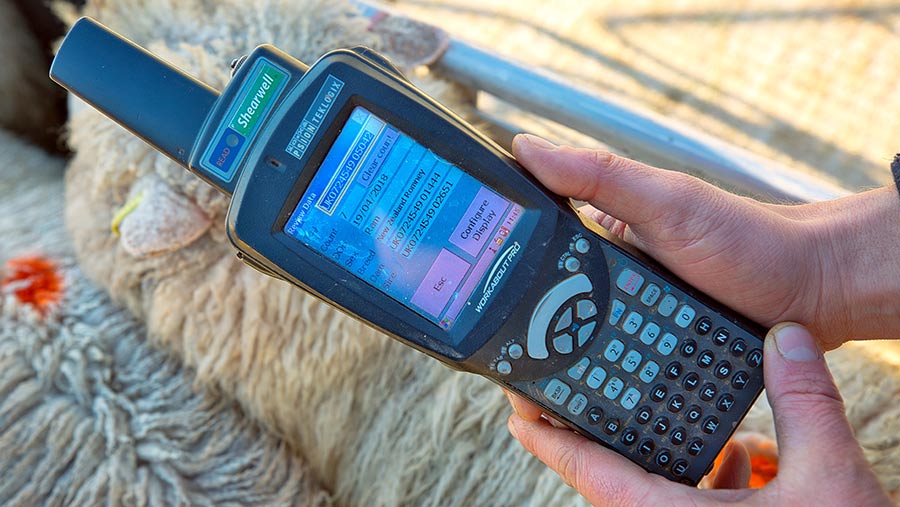How hill farmers keep production costs to £43 a ewe
 High Country Romneys © Richard-Stanton
High Country Romneys © Richard-Stanton Penny Chantler and her sons, William and Sam Sawday, are improving profitability at the 188ha Hill Farm, Llanigon, Hay-on-Wye, by keeping production costs in their sheep enterprise low at just £43 a ewe.
The family have been breeding for efficiency in their flock of 1,400 Romney ewes (600 stud flock and 800 commercial) for more than 30 years.
They reckon a breed with the correct traits and the raw genetic potential will deliver maximum profits. Their motto is: “Yield is vanity, profit is sanity.”
William adds: “Our aim is to produce as many lambs as possible off the land with minimal inputs. Making the most of grass is key to that.”
Farm facts
- 600 recorded ewes in the stud flock (400 Romney and 200 Romney Texel)
- Rams sold throughout the UK
- 800 ewes in the commercial flock, which was set up in 2013
- Ewes are drafted out of the stud flock into the commercial flock
- Low-input grassland-based upland hill farm
- Outdoor lambing
- Genetics sourced from New Zealand every couple of years
- Sheep Improvement Ltd (SIL) recording system, as the farm is based on New Zealand genetics
- In the top 3% of flocks on the SIL database
The £43 a ewe figure covers all costings, including rent, forage crops and reseeds at £19 a ewe, with no concentrates used. Their vet and medicines costs are also very low at £5.70 a ewe.

Penny Chantler and her sons, William and Sam Sawday © Richard Stanton
See also: 7 crucial topics for sheep business viability
How they are keeping costs low
Grazing
All ewes are rotationally grazed on a 35- to 40-day rotation and are stocked at four ewes plus lambs to the acre (10 ewes/ha). Ewes are moved weekly and enter grazing covers at 2,500kg DM/ha.
They are grazed mainly on permanent pasture, the majority of which is between 230-380m above sea level.
Very little fertiliser is applied. A small amount of forage crops is grown each year, and this is followed by a reseed using a herbal ley.
Breeding
Identifying superior animals using estimated breeding values (EBVs) and performance data allows the family to select the most efficient animals for their system.
William and Sam talk through their selection criteria, which is based on nine key points.
-
High weaning percentage
The number of lambs reared, and their weaning weight, are two of the most important selection criteria for the family.
The High-Country Romneys scan at 175-185% and wean more than 160%. This is helped by the ewes being highly fertile, with the majority falling pregnant within the first cycle.
The stud flock is single-sire mated and the commercials are mob-mated at about 80-120 ewes a ram. Neither of the flocks are flushed.
Over the past seven years, they have been able to reduce their losses from scanning to weaning from 25% to 15% by focusing on lamb survival.
The maternal ability of the ewe ensures high lamb survival. Within 24 hours of lambs being born into the stud flock, they are caught, tagged and recorded using a handheld electronic identification reader.
Parentage and birthweight are recorded and then the ewe and lambs are scored for lamb vigour, lambing ease, intervention, teat placement, lambs born, deaths and reasons for deaths are noted. These are all used to help inform future breeding decisions.
Lambing outdoors means it is important to breed ewes with a strong maternal ability and for lambs to get up as soon as they are born.

Lambs are recorder using an electronic identification reader within 24 hours of being born © Richard Stanton
-
Growth rates
It is believed lamb growth rates make up 45% of flock profitability, compared with 3% for conformation.
For the first couple of months, lamb growth rates are determined by ewe milk yield, which is why the family also place a strong emphasis on ewe maternal ability.
Once lambs are weaned onto grass, feed conversion plays a vital role.
Average lamb growth rates are currently about 250g/day, with some achieving up to 400g/day off grass alone. Lambs in the commercial flock are drafted from summer onwards, killing out at 38-42kg deadweight.
Lambs are weighed regularly throughout the year. In the stud flock, the two most important weights are taken at weaning and in the autumn, which help determine growth and meat EBVs.
Backfat measurements are also taken at the autumn weighing for meat yield EBVs.
-
Maternal instincts
Romneys are bred to be low-maintenance and to lamb with minimal assistance outside. Any ewes requiring assistance are not bred from again.
Last year, the number of assisted births could be counted on one hand in the stud flock, says William.
-
Worm resistance
The family have been selecting for Worm resistance for more than 20 years. They are in the top 1% of Romney flocks on the New Zealand-based Sheep Improvement Ltd (SIL) recording database for worm resistance.

SIL software is used for recording © Richard Stanton
The worm resistance trait in sheep is 25-30% heritable. The benefits of breeding for worm resistance include reducing the contamination of pasture with worms, reducing the reliance on wormers and improving growth rates.
At Hill Farm, individual faecal egg count (FEC) samples are taken from a large number of ram lambs to determine their ability to fight infection naturally. This is then used to generate a FEC EBV.
Lambs are also dag scored using the SIL six-point system to reduce the incidence of dags (which is 20% heritable) and eliminate the requirement for crutching.
As a result, fly strike has also reduced. The aim is to stop the preventative treatment for flies in future by culling any sheep that are treated for strike.
-
Survivability
Breeding a ewe that can cope 300m above sea level in the Welsh hills is important, which is why survivability has been included in Hill Farm’s selection criteria.
On average, ewes are producing until their eight year. Williams says: “We have plenty of nine-year-old ewes in our flock. Romneys tend not to lose their teeth. This also helps reduce the replacement rate, meaning we can sell more.”
The replacement rate in the stud flock runs at about 25-28% to maximise genetic selection and progress. In the commercial flock, the replacement rate is about 17-20%.
Sam says: “We draft some of our ewes from the stud flock into the commercial flock if they only have minor offences. We then use our high-genetic merit rams over our commercial flock to continue improvement.
“Culling isn’t quite so hard in the commercial flock, which is why the replacement rate is lower.”
-
Meat yield
Although conformation only contributes to 3% of flock profitability, the family still believe meat yield is important. They scan many stud lambs for backfat percentage.
Including this in their selection ensures they are breeding an animal that can meet target specification.
-
Good wool
Romneys at Hill Farm are sheared twice a year in June and late October – an expense the family say is justified due to the higher price received for the Romney fleece. They are breeding for a sheep with a heavy fleece, with a good crimp and lustre.
-
Structure
The family will only breed from animals that are structurally correct. They will not breed from animals that have had lameness issues.
Other physical attributes such as teat placement and teeth are recorded and included in their breeding decisions.
-
Ewe weight
The target ewe mature weight is 65kg. A smaller ewe requires less feed and it is therefore easier for a smaller ewe to rear her bodyweight in lambs – their target.
The feed costs of a smaller ewe are also less, and stocking rates can be increased.
Williams says: “There is a balance to be struck when producing lambs that grow well. But with fewer feed inputs, we are able to rear lambs that reach their most economical slaughter weight as quickly as possible while accumulating fewer costs in the process.”
